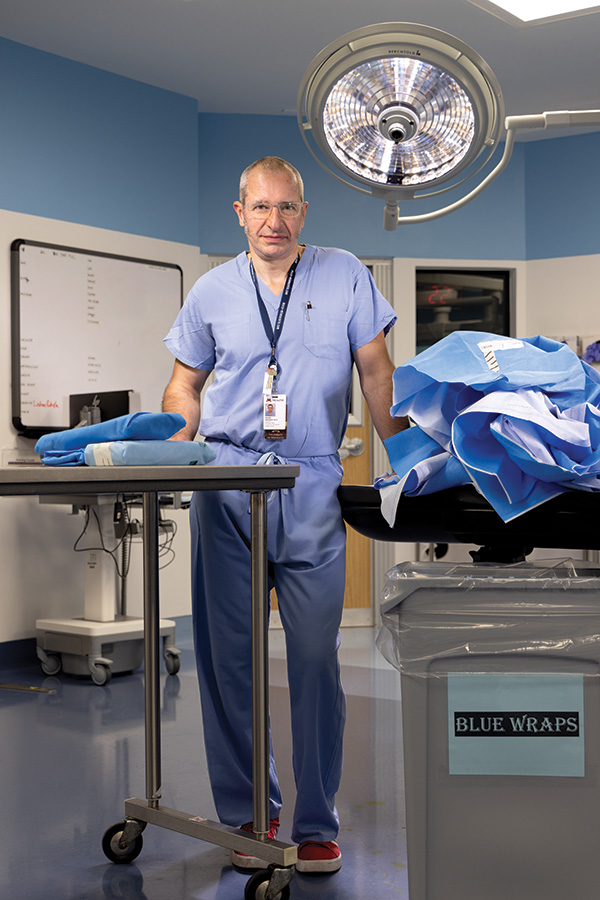
Rafael Andrade, MD (MHA ’17), is a professor at the University of Minnesota Medical School and an M Health Fairview surgeon. He’s tackling a big problem in medicine: sustainability. The medical sector uses vast amounts of energy and water and, according to Practice Greenhealth, generates more than 5 million tons of waste each year. Dr. Andrade is implementing efforts at MHealth Fairview to address this problem, including a collaboration with Merrick, Inc. (a St. Paul day service for adults with intellectual and developmental disabilities) to recycle sterile “blue wrap” used to protect surgical instruments.
Q. Why is the lack of sustainability in medicine so important to you?
Andrade: I grew up in Mexico City, and that set the stage for my sensitivity about the environment, because the city was so polluted. As a kid it already bothered me.
Healthcare is one of the highest energy consuming enterprises in the country. Part of it is understandable, because so many things have to be sterilized and packaged appropriately. But there are very, very few health systems that have made a concerted effort to be more sustainable.
Q. What are the big targets for you to make medicine more responsible?
Andrade: Energy, water, chemicals, plastic, disposables. The handful of institutions that have tried to become more sustainable consistently show that they save money over time by doing so. But many healthcare systems are struggling financially, so the thought of investing in being more environmentally responsible without seeing an immediate tangible effect is not attractive. It doesn’t match the mission of hospitals to ignore sustainability. But it’s not on anyone’s radar.
Decades ago, the medical device industry started focusing a lot on disposable stuff. They had this very narrow view that you can buy one item for a dollar and then you throw it away without having to sterilize it. So you buy a thousand items for $1 and then throw them away. But you could have bought a permanent item for $10 and sterilized it between uses and it’d be at least a wash, if not less expensive. Everything is disposable now.
“The handful of institutions that have tried to become more sustainable consistently show that they save money over time by doing so.”
Rafeal Andrade
Q. What are you doing to address that problem?
Andrade: We started at M Health Fairview with grassroots efforts in the operating room. We’ve recycled blue wrap with a local organization, Merrick Inc., that turns it into bags and buckets and other things. We’ve done some recycling of plastic bottles and cardboard.
In the pre-op area, patients always put their personal belongings in a plastic bag, which then gets thrown away. One of our nurses received a grant and bought reusable bins. So now patient belongings go into a reusable bin, then we clean the bin and use it for the next patient.
To link waste savings with cost savings for my MHA capstone project, I took on a high-visibility, high-cost procedure that’s done in the operating room. We have a fully disposable backup kit of instruments wrapped in blue wrap. It’s routinely opened for each procedure and discarded if not used. I found that by not opening the kit that weighs about 18 pounds and costs $300 unless we need to, it adds up to about $18,000 in savings a year.
Here’s another example: In some of the surgeries I perform, we use staplers powered by one-time-use batteries, which we then throw away. Now we’re doing minimally invasive lung surgery that’s more difficult to perform, but doesn’t require staplers. (We collaborated with surgeons in Brazil to learn how to do it. They do it out of necessity because they don’t have as much access to staplers.) We’ve now done more than 25 cases with very good clinical results, and we’re saving about three pounds of waste and $2,000 to $3,000 per case.
Q. What would it look like for a health system to make sustainability a priority?
Andrade: Ideally, we would have a chief sustainability officer who reports directly to the CEO and has a seat at the table, just like the CFO and the CIO. Someone in charge of sustainability who can say, “I know this choice is a little cheaper right now, but what’s it going to look like in 10 years, what are the potential savings of another choice, and what is the effect on the community?” Sustainability has to have the same weight at the executive level as operations and finances.
People who work in healthcare want the industry to be more sustainable, but most people don’t want to lead that effort. To make a lasting change, leadership in sustainability must be prioritized at the institutional level.


